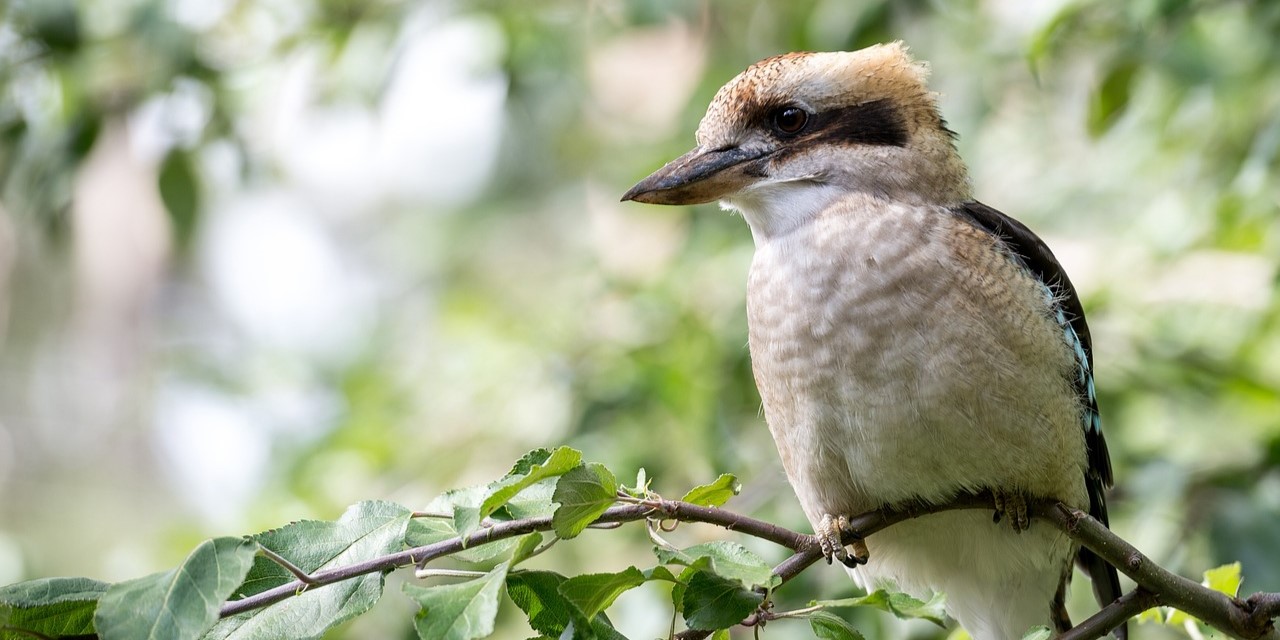
Kookaburras are remarkable birds, most well-known for their unique laughs and curious personalities. Kookaburras show up at Long Point Conference Centre year round and our guests often enjoy waking up to the sound of them.
The laughing kookaburra (Dacelo novaeguineae) is a large bird in the kingfisher subfamily Halcyoninae. Sporting a whitish head and a brown eye-stripe, it’s native to eastern mainland Australia. However, it has also been introduced to different areas, such as parts of New Zealand, Tasmania and Western Australia.
10 Fun Facts About Kookaburras
1. They have a bold and distinctive laugh
Kookaburras are early risers, and their distinctive laughter, often described as resembling human laughter, can be heard in the early morning hours.
2. Kookaburras are excellent hunters
Despite their jovial demeanour, kookaburras are skilled predators, feeding on insects, small mammals, lizards and even snakes. Their strong beaks are designed for grabbing and devouring prey.
3. They live in close-knit family groups
Kookaburras are family-oriented birds, with younger members helping their parents raise the chicks.
4. Kookaburras have remarkable eyesight
This allows them to spot prey from great distances. Their keen vision, coupled with a patient attitude, makes them efficient hunters in the wild.
5. Laughing to establish territory
Their famous laughter isn’t just for amusement; it serves a bigger purpose. Kookaburras use their distinctive calls not only to communicate with each other but also to establish and defend their territory.
6. Choosing simple housing over complex nests
Unlike many other birds, kookaburras don’t build intricate nests. Instead, they often use tree hollows for shelter and nesting. It’s a practical approach that fits their easygoing lifestyle.
7. A kookaburra pair stays together for life
Kookaburras are known for forming strong monogamous bonds. Once a pair is established, they tend to stay together for life (around 10-20 years), sharing the responsibilities of raising their feathered family.
8. Females kookaburras are bigger than males
These birds are no small talkers; Kookaburras can reach up to 43 cm in length, with females generally being slightly larger than males.
9. Feathers help with camouflage
The kookaburra uses its brown and white feathers to blend into its environment, making it harder for both prey and predators to spot.
10. Kookaburras spread their wings after rain
Kookaburras have a unique behaviour of spreading their wings after rainfall. Some experts believe this is a way to dry and warm themselves, while another popular theory is that it could be a form of communication within the group.
Frequently Asked Questions About Kookaburras
What does ‘kookaburra’ mean?
The term ‘kookaburra’ is believed to originate from the Aboriginal word ‘guuguuberra’, possibly imitating the bird’s distinctive laughing call.
How many types of kookaburras are there?
There are four main species of kookaburras:
- Laughing kookaburra
- Blue-winged kookaburra
- Spangled kookaburra
- Rufous-bellied kookaburra.
What is a kookaburra’s habitat?
Kookaburras are found in various habitats across Australia, including forests, woodlands and even urban areas. They prefer areas with sufficient perching spots, tree hollows and access to water. The song ‘Kookaburra Sits in the Old Gum Tree’ is a classical, Australian favourite which talks about the kookaburra in its natural habitat.
What do kookaburras eat?
These large birds are carnivorous and primarily feed on insects, small mammals, reptiles and even small birds. Their strong beaks help them catch and consume a diverse range of prey.
What does a kookaburra sound like?
The sound of a kookaburra is often described as laughter, resembling a human chuckle. This iconic call is a territorial behaviour and a way for them to communicate with their family group.
What is a group of kookaburras called?
A group of kookaburras is called a flock or a riot.
Can I feed a wild kookaburra?
While it may be tempting, it’s generally not recommended to feed wild kookaburras. Dependence on human food can disrupt their natural diet and behaviour. It’s best to appreciate them from a distance.
What is the lifespan of a kookaburra?
In the wild, kookaburras typically live up to 10-20 years. However, their lifespan can vary based on factors like habitat, food availability and the presence of predators.
Are kookaburras only found in Australia?
Kookaburras are native to Australia and New Guinea, but may also be found in some parts of New Zealand. It was reported by various media outlets in March 2024 that a kookaburra from Australia was found in the English countryside, specifically in Suffolk. Locals have been catching glimpses of this presumed escapee since 2015. No one is certain where it escaped from, but it seems to enjoy the current, dry climate of this area.
Are kookaburras aggressive to humans?
Kookaburras are not usually aggressive towards humans. They may, however, show territorial behaviour if they feel their space is being invaded. This is the case for most animals, including koalas.
Do kookaburras have any special traits?
Kookaburras have several unique traits, including their distinctive laughter, strong beaks for hunting and monogamous bonding. They are also known for their adaptability to various environments, including urban settings.
Will I See Kookaburras at Long Point Conference Centre?
It’s not unlikely that you’ll see or hear kookaburras at our group accommodation venue. According to Animalia, they do not migrate but occupy the same territory throughout the whole year. Kookaburras love the gumtrees and you may hear them around sunrise or sunset, depending on the time of year.
If you would like to book accommodation for a family reunion, school camp or other event, contact us to arrange an inspection!
